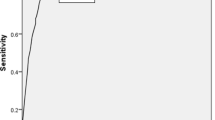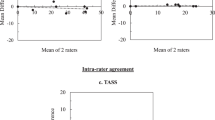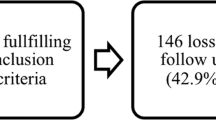Abstract
Study Design
Prospective cohort study.
Objectives
To investigate the sensitivity to change and prognostic validity of Trunk Control Test (TCT) and Thoracic-Lumbar Control Scale (TLC) in terms of mobility in persons with motor complete thoracic spinal cord injury (SCI).
Setting
Participants were recruited at an Italian SCI rehabilitation facility from October 2015 to January 2020.
Methods
Inclusion criteria were acute traumatic or non-traumatic event and T1-L1 neurological level. Trunk control and mobility were assessed at baseline, discharge, and at 6 and 18-month follow-ups. Mobility was measured using Spinal Cord Independence Measure III mobility subscale. Linear regression models were used to analyze changes in trunk control and mobility over time, and the relationship between these measures.
Results
The 39 participants were predominantly male, with a mean age of 38 years. Trunk control improved during rehabilitation, at 6-month follow-up, and remained stable thereafter, according to TCT and TLC scales. A higher baseline TCT score was associated with improvements in mobility at discharge and at follow-ups. Baseline TLC score and its change during rehabilitation were unrelated with changes in mobility.
Conclusions
Results suggest that the TCT and TLC scales are useful to capture changes in trunk control during the acute and subacute phases. Improvements in functional mobility are however associated with TCT score only, suggesting the potential of this test as a useful prognostic indicator. Further research with larger sample sizes is warranted to determine whether these findings are consistent across neurological level strata.
This is a preview of subscription content, access via your institution
Access options
Subscribe to this journal
Receive 12 print issues and online access
$259.00 per year
only $21.58 per issue
Buy this article
- Purchase on Springer Link
- Instant access to full article PDF
Prices may be subject to local taxes which are calculated during checkout


Similar content being viewed by others
Data availability
The dataset generated and analyzed during the current study is available from the corresponding author on reasonable request.
References
Perez-SanPablo AS, Quinzaños-Fresnedo J, Lopez-Romero JC, Quiñones-Uriostegui I. Reliability of posturographic measures obtained during instrumental assessment of trunk control using inertial sensors in individuals with spinal cord injury. Ann Phys Rehabil Med. 2018;61S:e84.
Miller WC, Chan WL, Noonan VN, Sakakibara BM, Tawashy AE, Aubut JL, et al. Outcome Measures. In: Eng JJ, Teasell RW, Miller WC, Wolfe DL, Townson AF, Hsieh JTC, et al. editors. Spinal Cord Injury Rehabilitation Evidence. Version 4.0. 2013. p. 28.1–28.366. https://it.scribd.com/document/429538318/Scire4-Om-Full-Ch. Accessed on 28 Aug 2023.
Thrasher TA, Sin VW, Masani K, Vette AH, Craven BC, Popovic MR, et al. Responses of the trunk to multidirectional perturbations during unsupported sitting in normal adults. J Appl Biomech. 2010;26:332–40.
Janssen-Potten YJ, Seelen HA, Drukker J, Reulen JP. Chair configuration and balance control in persons with spinal cord injury. Arch Phys Med Rehabil. 2000;81:401–8.
Ciardi G, Nicolini L. Evaluation of seated trunk postural control in patients with spinal cord injury: systematic review of literature. Ann Physiother Occup Ther. 2021;4:000188.
Quinzaños J, Villa AR, Flores AA, Pérez R. Proposal and validation of a clinical trunk control test in individuals with spinal cord injury. Spinal Cord. 2014;52:449–54.
de Abreu DC, Takara K, Metring NL, Reis JG, Cliquet A Jr. Interference of different types of seats on postural control system. Int J Rehabil Res. 2012;35:208–13.
Karataş GK, Tosun AK, Kanatli U. Center-of-pressure displacement during postural changes in relation to pressure ulcers in Spinal Cord-Injured patients. Am J Phys Med Rehabil. 2008;87:177–82.
Invernizzi M, Carda S, Milani P, Mattana F, Fletzer D, Iolascon G, et al. Development and validation of the Italian version of the spinal cord independence measure III. Disabil Rehabil. 2010;14:1194–203.
Corallo V, Torre M, Ferrara G, Guerra F, Nicosia G, Romanelli E, et al. What do spinal cord injury patients think of their improvement? A study of the minimal clinically important difference of the Spinal Cord Independence Measure III. Eur J Phys Rehabil Med. 2017;53:508–15.
Quinzaños-Fresnedo J, Fratini-Escobar PC, Almaguer-Benavides KM, Aguirre-Güemez AV, Barrera-Ortíz A, Pérez-Zavala R, et al. Prognostic validity of a clinical trunk control test for independence and walking in individuals with spinal cord injury. J Spinal Cord Med. 2020;43:331–8.
Atkinson D, Atkinson K, Kern M, Hale J, Feltz M, Graves DE, et al. Graves-Atkinson scale: a thoracic-lumbar control scale for use in spinal cord injury research. User’s manual. Available at: http://www.tbicommunity.org/txmscis/projects/trunkScale/Trunk_Scale_Photo_version.pdf. Accessed on 1 May 2009.
Pastre CB, Lobo AM, Oberg TD, Pithon KR, Yoneyama SM, Lima NM, et al. Validation of the Brazilian version in Portuguese of the Thoracic-Lumbar Control Scale for spinal cord injury. Spinal Cord. 2011;49:1198–202.
Maynard FM Jr, Bracken MB, Creasey G, Ditunno JF Jr, Donovan WH, Ducker TB, et al. International Standards for Neurological and Functional Classification of Spinal Cord Injury. American Spinal Injury Association. Spinal Cord. 1997;35:266–74.
NSCISC Annual statistical Report 2020. https://www.nscisc.uab.edu/Public/2020%20Annual%20Report%20-%20Complete%20Public%20Version.pdf. Accessed on 23 Feb 2022
Aidinoff E, Front L, Itzkovich M, Bluvshtein V, Gelernter I, Hart J, et al. Expected spinal cord independence measure, third version, scores for various neurological levels after complete spinal cord lesions. Spinal Cord. 2011;49:893–6.
Atkinson D, Atkinson K, Kern M, Hale J, Feltz M, Graves DE. Poster 38: reliability of a thoracic-lumbar control scale for use in spinal cord injury research. Arch Phys Med Rehabil. 2008;89:e18.
Linn BS, Linn MW, Gurel L. Cumulative illness rating scale. J Am Geriatr Soc. 1968;16:622–6.
Chen CL, Yeung KT, Bih LI, Wang CH, Chen MI, Chien JC, et al. The relationship between sitting stability and functional performance in patients with paraplegia. Arch Phys Med Rehabil. 2003;84:1276–81.
Magnani PE, Cliquet A Jr, de Abreu DCC. Postural control assessment in physically active and sedentary individuals with paraplegia. Acta Ortop Bras. 2017;25:147–50.
Peeters LHC, de Groot IJM, Geurts ACH. Trunk involvement in performing upper extremity activities while seated in neurological patients with a flaccid trunk - a review. Gait Posture. 2018;62:46–55.
Seelen HA, Potten YJ, Adam JJ, Drukker J, Spaans F, Huson A, et al. Postural motor programming in paraplegic patients during rehabilitation. Ergonomics. 1998;41:302–16.
Seelen HA, Potten YJ, Drukker J, Reulen JP, Pons C. Development of new muscle synergies in postural control in spinal cord injured subjects. J Electromyogr Kinesiol. 1998;8:23–34.
Potten YJ, Seelen HA, Drukker J, Reulen JP, Drost MR. Postural muscle responses in the spinal cord injured persons during forward reaching. Ergonomics. 1999;42:1200–15.
Seelen HA, Potten YJ, Huson A, Spaans F, Reulen JP. Impaired balance control in paraplegic subjects. J Electromyogr Kinesiol. 1997;7:149–60.
Ilha J, Abou L, Romanini F, Dall Pai AC, Mochizuki L. Postural control and the influence of the extent of thigh support on dynamic sitting balance among individuals with thoracic spinal cord injury. Clin Biomech (Bristol, Avon). 2020;73:108–14.
Gabison S, Verrier MC, Nadeau S, Gagnon DH, Roy A, Flett HM. Trunk strength and function using the multidirectional reach distance in individuals with non-traumatic spinal cord injury. J Spinal Cord Med. 2014;37:537–47.
Milosevic M, Gagnon DH, Gourdou P, Nakazawa K. Postural regulatory strategies during quiet sitting are affected in individuals with thoracic spinal cord injury. Gait Posture. 2017;58:446–52.
Acknowledgements
We wish to thank Dr. Jessica Cambiuzzi and Dr. Francesco Coschignano for their support in data acquisition, and Dr. Tiziana Giovannini for her support in designing the study protocol. Elisa Maietti was a brilliant statistician and an unforgettable joyful, radiant, generous and supportive colleague. This paper is dedicated to her memory.
Funding
No research grant was received for this study.
Author information
Authors and Affiliations
Contributions
PP was responsible for designing the study protocol, conducting the study, screening potentially eligible patients, and writing the first draft of the manuscript. MM was responsible for conducting the study, screening potentially eligible patients, and interpreting results. IB provided feedback on the manuscript, and was responsible for submitting the study to the ethics committee. CK was responsible for supervising the research group and contributed to the paper writing. SN revised the manuscript for important intellectual content. EM performed the data analysis and contributed to interpreting the results and writing the draft. All authors approved the final version of the paper.
Corresponding author
Ethics declarations
Competing interests
The authors declare no competing interests.
Informed consent
All participants provided written, informed consent and anonymity was maintained throughout the research process.
Ethical approval
Ethical approval (ethics committee code 15013, 25/06/2015) was granted by the local ethics committee (Comitato Etico Interaziendale Bologna-Imola).
Additional information
Publisher’s note Springer Nature remains neutral with regard to jurisdictional claims in published maps and institutional affiliations.
Supplementary information
Rights and permissions
Springer Nature or its licensor (e.g. a society or other partner) holds exclusive rights to this article under a publishing agreement with the author(s) or other rightsholder(s); author self-archiving of the accepted manuscript version of this article is solely governed by the terms of such publishing agreement and applicable law.
About this article
Cite this article
Paglierani, P., Marani, M., Maietti, E. et al. Prognostic validity of trunk control scales for mobility in individuals with motor complete thoracic SCI: a prospective cohort study. Spinal Cord 61, 529–535 (2023). https://doi.org/10.1038/s41393-023-00929-8
Received:
Revised:
Accepted:
Published:
Issue Date:
DOI: https://doi.org/10.1038/s41393-023-00929-8



